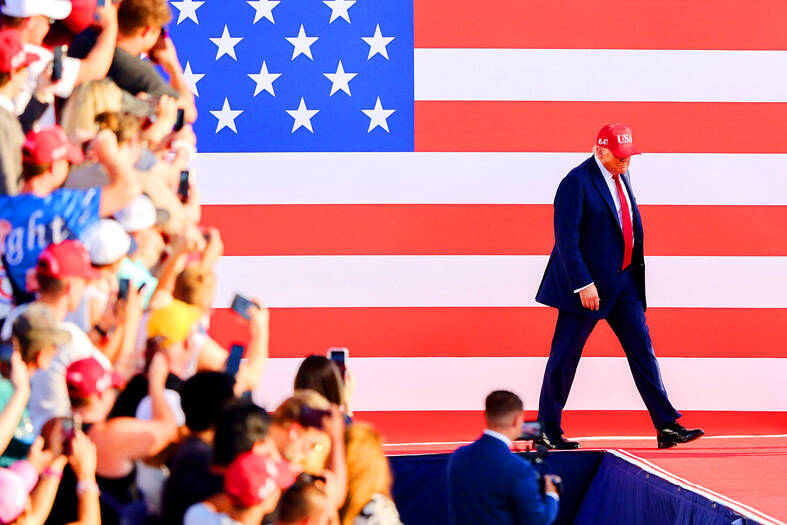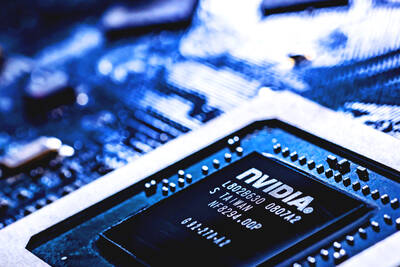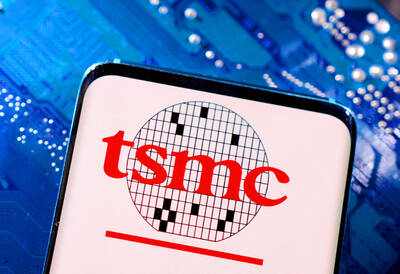US President Donald Trump on Thursday said that his administration would start sending out letters to trading partners yesterday setting unilateral tariff rates, which he said countries would have to begin paying on Aug. 1
Trump told reporters that about 10 or 12 letters would go out yesterday, with additional letters coming over the next few days.
“I think by the ninth they’ll be fully covered,” Trump added, referring to a Wednesday next week deadline he initially set for countries to reach deals with the US to avoid higher import duties he has threatened.

Photo: Bloomberg
“They’ll range in value from maybe 60 or 70 percent tariffs to 10 and 20 percent tariffs,” he said.
The top tier of that range, if formalized, would be higher than any tariffs the president initially outlined during his “Liberation Day” rollout in early April. Those ranged from a 10 percent baseline tariff on most economies up to a maximum of 50 percent.
Trump did not elaborate on which countries would get the tariffs or whether that meant certain goods would be taxed at a higher rate than others.
Trump said that countries would “start to pay on August 1. The money will start going to come into the United States on August 1.”
Tariffs are typically paid by the importer, or an intermediary acting on the importer’s behalf, but it is often the end consumer that ultimately shoulders much of the cost.
The US president initially announced his higher so-called “reciprocal” tariffs on April 2, but paused those for 90 days to allow countries time to negotiate, putting in place a 10 percent rate during that interval.
So far, the Trump administration has announced deals with the UK and Vietnam, and agreed to a truce with China that saw the world’s two largest economies ease tit-for-tat tariffs.
Asked if more deals were on the way, Trump on Thursday responded that “we have a couple of other deals, but you know, my inclination is to send a letter out and say what tariffs they are going to be paying.”
Trump announced the Vietnam deal on Wednesday, saying that the US would place a 20 percent tariff on Vietnamese exports to the US and a 40 percent rate on goods deemed transshipped through the nation — a reference to the practice whereby components from China and possibly other nations are routed through third countries on their way to the US.
While the rates are lower than the 46 percent duty Trump imposed on Vietnam initially, they are higher than the universal 10 percent level, and many of the particulars of the deal are still unclear, with the White House yet to release a term sheet or publish any proclamation codifying the agreement.
Investors who have eagerly anticipated any deals between the US and trading partners were buoyed on Wednesday by the Vietnam announcement, which saw share prices of US manufacturers with facilities in the country rise.
Many major US trading partners, such as Japan, South Korea and the EU, are still working to finalize deals.
Trump has expressed optimism about reaching an agreement with India, but has spoken harshly about the prospects of an accord with Japan, casting Tokyo as a difficult negotiating partner.
He intensified his criticism this week, saying that Japan should be forced to “pay 30 percent, 35 percent or whatever the number is that we determine.”
Trump on Tuesday also said that he was not considering delaying next week’s deadline.
Asked about any potential extension of talks, US Secretary of the Treasury Scott Bessent on Thursday said that Trump would make the final call.
“We’re going to do what the president wants, and he’ll be the one to determine whether they’re negotiating in good faith,” Bessent said.

When Lika Megreladze was a child, life in her native western Georgian region of Guria revolved around tea. Her mother worked for decades as a scientist at the Soviet Union’s Institute of Tea and Subtropical Crops in the village of Anaseuli, Georgia, perfecting cultivation methods for a Georgian tea industry that supplied the bulk of the vast communist state’s brews. “When I was a child, this was only my mum’s workplace. Only later I realized that it was something big,” she said. Now, the institute lies abandoned. Yellowed papers are strewn around its decaying corridors, and a statue of Soviet founder Vladimir Lenin

UNIFYING OPPOSITION: Numerous companies have registered complaints over the potential levies, bringing together rival automakers in voicing their reservations US President Donald Trump is readying plans for industry-specific tariffs to kick in alongside his country-by-country duties in two weeks, ramping up his push to reshape the US’ standing in the global trading system by penalizing purchases from abroad. Administration officials could release details of Trump’s planned 50 percent duty on copper in the days before they are set to take effect on Friday next week, a person familiar with the matter said. That is the same date Trump’s “reciprocal” levies on products from more than 100 nations are slated to begin. Trump on Tuesday said that he is likely to impose tariffs

HELPING HAND: Approving the sale of H20s could give China the edge it needs to capture market share and become the global standard, a US representative said The US President Donald Trump administration’s decision allowing Nvidia Corp to resume shipments of its H20 artificial intelligence (AI) chips to China risks bolstering Beijing’s military capabilities and expanding its capacity to compete with the US, the head of the US House Select Committee on Strategic Competition Between the United States and the Chinese Communist Party said. “The H20, which is a cost-effective and powerful AI inference chip, far surpasses China’s indigenous capability and would therefore provide a substantial increase to China’s AI development,” committee chairman John Moolenaar, a Michigan Republican, said on Friday in a letter to US Secretary of

Taiwan Semiconductor Manufacturing Co’s (TSMC, 台積電) market value closed above US$1 trillion for the first time in Taipei last week, with a raised sales forecast driven by robust artificial intelligence (AI) demand. TSMC saw its Taiwanese shares climb to a record high on Friday, a near 50 percent rise from an April low. That has made it the first Asian stock worth more than US$1 trillion, since PetroChina Co (中國石油天然氣) briefly reached the milestone in 2007. As investors turned calm after their aggressive buying on Friday, amid optimism over the chipmaker’s business outlook, TSMC lost 0.43 percent to close at NT$1,150